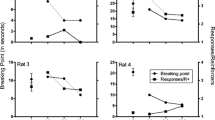Abstract
Recent studies have shown that naloxone and other opiate antagonists can reduce the amounts of food and water consumed by laboratory animals, a finding consistent with a role for endogenous opioids in the control of appetite. Because there have also been some failures to observe an anorectic action of naloxone, a study was carried out in which the effects of the drug on food intake were investigated using two different experimental procedures. In naive rats deprived of food for 24 h, both naloxone (0.1, 1.0 and 10.0 mg/kg) and fenfluramine (1.0, 3.0 and 10.0 mg/kg) produced dose-related decreases in food and water intake. In rats which has been adapted to receiving food for only 6 h each day, fenfluramine produced a similar effect whereas naloxone had no effect on food intake and reduced water consumption only at the highest dose. A second experiment showed that the different actions of a 1.0 mg/kg dose of naloxone in the two procedures were not due to differences in the duration of the immediately preceding period of food deprivation or in the time during which the rats were handled. These results show that the anorectic action of naloxone can be attenuated by adaptation to a schedule of repeated food deprivation.
Similar content being viewed by others
References
Antelman SM, Rowland N (1981) Endogenous opiates and stress-induced eating. Science 214:1149–1150
Brown DR, Holtzman SG (1979) Suppression of deprivation-induced food and water intake in rats and mice by naloxone. Pharmacol Biochem Behav 11:567–573
Brown DR, Holtzman SG (1980) Evidence that opiate receptors mediate suppression of hypertonic saline-induced drinking in the mouse by narcotic antagonists. Life Sci 26:1543–1550
Brown DR, Holtzman SG (1981) Suppression of drinking by naloxone in the rat: A further characterization. Eur J Pharmacol 69:331–340
Cooper SJ (1980) Naloxone: Effects on food and water cosumption in the non deprived and deprived rat. Psychopharmacology 71:1–6
Czech DA, Stein EA (1980) Naloxone depresses osmoregulatory drinking in rats. Pharmacol Biochem Behav 12:987–989
Deakin JFW, Longley DC (1981) Naloxone enhances neophobia. Br J Pharmacol 74:210
Frenk H, Rogers GH (1979) The suppressant effects of naloxone on food and water intake in the rat. Behav Neurol Biol 26:23–40
Goudie AJ, Demellweek C (1980) Naloxone failsto block amphetamineinduced anorexia and conditioned taste aversion. J Pharm Pharmacol 32:653–656
Holtzman SG (1974) Behavioral effects of separate and combined administration of naloxone and d-amphetamine. J Pharmacol Exp Ther 189:51–60
Kyriakides M, Silverstone T, Jeffcoate W, Laurance B (1980) Effect of naloxone on hyperphagia in Prader-Willi syndrome. Lancet I:876–877
Lowy MT, Maickel RP, Yim GKW (1980) Naloxone reduction of stress-related feeding. Life Sci 26:2113–2118
Margules DL (1979) Beta-endorphin and endoloxone: Hormones of the autonomic nervous system for the conservation or expenditure of bodily resources and energy in anticipation of famine or feast. Neurosci Biobehav Rev 3:155–162
McCarthy PS, Dettmar PW, Lynn AG, Sanger DJ (1981) Anorectic actions of the opiate antagonist naloxone. Neuropharmacology 12:1347–1349
Morley JE (1980) The neuroendocrine control of appetite: The role of the endogenous opiates, cholecystokinin, TRH, gamma-aminobutyric acid and the diazepam receptor. Life Sci 27:355–368
Morley JE, Levine AS (1980) Stress-induced eating is mediated through endogenous opiates. Science 20:1259–1261
Ostrowski NL, Rowland N, Foley TL, Nelson JL, Reid LD (1981) Morphine antagonists and consummatory behaviors. Pharmacol Biochem Behav 14:549–559
Rowland N (1982) Comparison of the suppression by naloxone of water intake induced in rats by hyperosmolarity, hypovolemia, and angiotensin. Pharmacol Biochem Behav 16:87–91
Sanger DJ (1981) Endophinergic mechanisms in the control of food and water intake. Appetite 2:193–208
Sanger DJ, McCarthy PS, Metcalf G (1981) The effects of opiate antagonists on food intake are stereospecific. Neuropharmacology 20:45–47
Schwartz TB (1981) Naloxone and weight reduction: An exereise in introspection. Trans Am Clin Chim Assoc 92:103–110
Stapleton JM, Lind MD, Merriman VJ, Reid LD (1979) Naloxone inhibits diazepam-induced feeding in rats. Life Sci 2421–2426
Author information
Authors and Affiliations
Rights and permissions
About this article
Cite this article
Sanger, D.J., McCarthy, P.S. The anorectic action of naloxone is attenuated by adaptation to a food-deprivation schedule. Psychopharmacology 77, 336–338 (1982). https://doi.org/10.1007/BF00432766
Received:
Issue Date:
DOI: https://doi.org/10.1007/BF00432766




